|
|
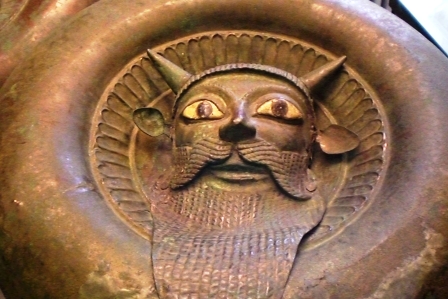
Military shield.
Etruscan. Bronze. Gregorian
Etruscan Vatican Museum, Rome.
Etruscans excelled at adorning their shields with a convincingly
ferocious-looking god. It was used to signal to the opponent that the gods
were on the side of the Etruscans. Perhaps the God-On-Shield also served as psychological reinforcement for
themselves. |
|
Etruscan Military and Society
Ancient Italy's tribal warfare
does not leave much for historians to ponder. You can spread out a map
of Italy and track when the peoples of one area crossed over into
another's area. Then set fires to crops and villages and killed or
enslaved whoever they found. That's about it.
The Etruscans, however, were
-more organized
and resource-rich.
-adopted Greek military tactics and weapons.
-then improved on them.
Their outburst of energy lasted several centuries. Bit by bit they conquered others to the north, in
the middle, and
to the south.
|
Etruscan
Society and Violence In addition to
finding joy in extreme luxury, the Etruscans also found it in extreme violence.
Etruscan funeral rites sometimes included human sacrifice of the owners'
slaves. Some slaves had to engage in ritualistic battle
until death. These
may have been the first "gladiators" of the ancient
world.
Etruscan chariot racing drew a ban from the Greek Olympics.
The Etruscan charioteer, unlike the Greek,
was sometimes strapped to his chariot with strong leather belts, with
the reins tied behind his back. The chariot became a virtual
prison for the driver. Racecourses had steep dips, bumpy hills, and
hair-raising
curves; fatal accidents were numerous, and probably expected.
|
|

Chariot racing.
Etruscan. Fresco, wall painting. Tomb in
Tarquinia, Italy. |
|
|
|
|
The Etruscans and Bronze: Military Gear
Many early Italian tribes and communities
fought in only leather
gear. Those who had bronze equipment
gained a considerable comparative advantage
militarily.
The Etruscans controlled the raw material that bronze is made of--copper and tin.
Just as important, the Etruscans were known technically skilled metal workers.
They could turn the raw material into the finished product without
having to depend upon another community.
What followed was a gush of bronze of top quality and significant
quantity.
In addition to bronze helmets, the Etruscans added bronze
protection for the heart area, shields, spears
and daggers, breastplates for the horses, and even musical instruments
for its military musicians.
|
|

Helmet.
Bronze.
Berlin, Altes Museum. To the basic Greek design, the Etruscans added
bronze neck and throat guards.

Modern drawing of a warrior's gear.
Etruscan, 8th c BC. Drawing.
The surviving artifacts are shown in red. Altes Museum, Berlin |
|
|
|
|
This is the
actual bronze
shield pictured in the drawing above.
On the reverse side of the shield are rattles, presumably to scare the
enemy as the warriors approached for combat. |
|
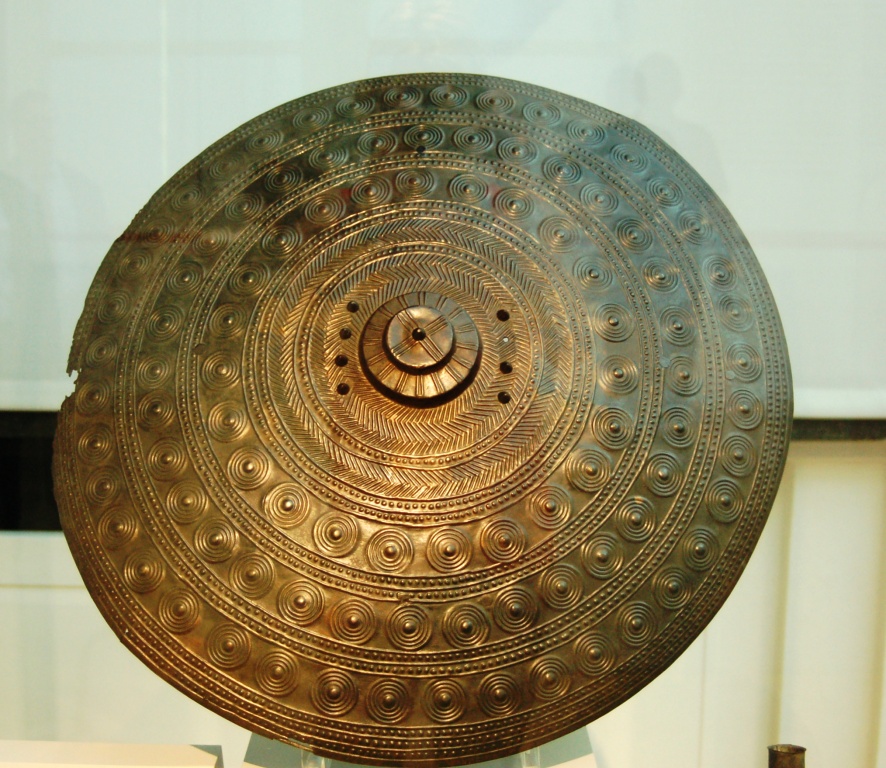
Military
shield, as depicted above in drawing. Etruscan.
8th c BCE. Bronze. Altes Museum (SMB), Berlin |
|
|
|
|
Etruscan Military Tactics
The Etruscans' power base lay between the Arno River (present-day Florence)
and the Tiber (Rome). From there, they expanded for over 250 years.
To the north, they defeated Gallic tribes that had crossed the Alps.
In the middle and south of Italy, they defeated other Italic tribes. At
its high point, over 12 important cities and many smaller communities
were part of the Etruscan polis.
The Etruscans never conquered Rome. |
|
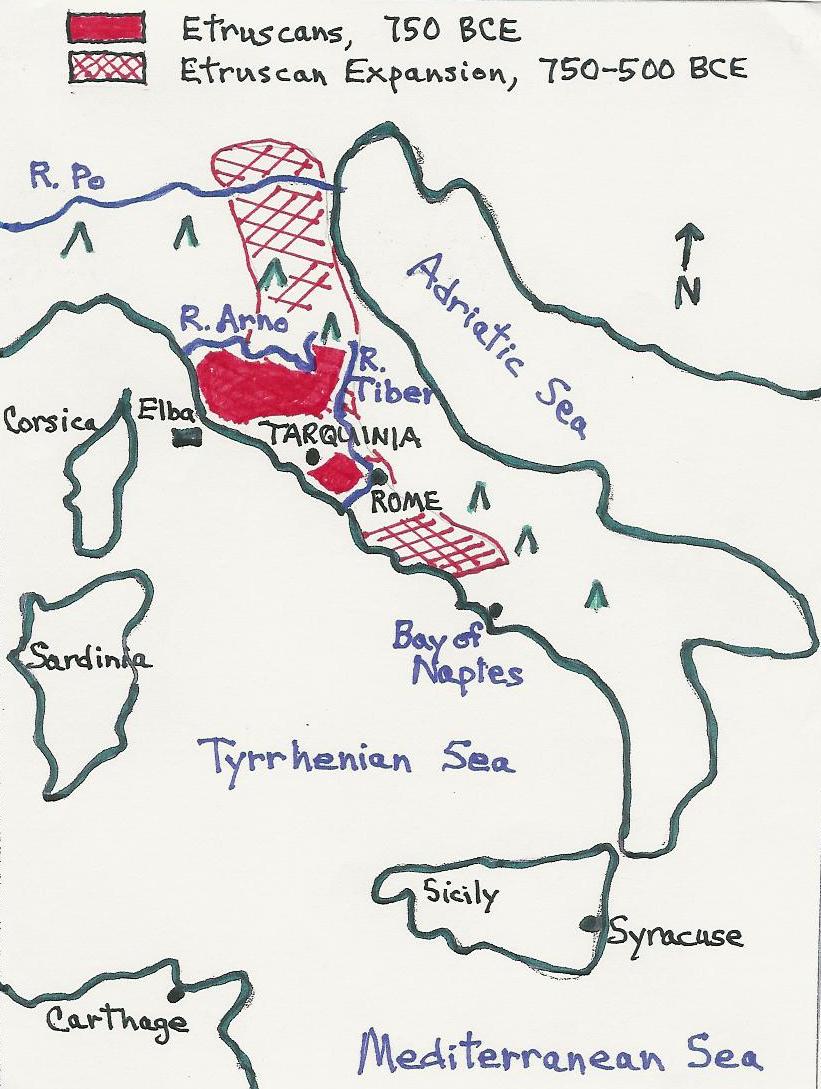
Map of Etruscan expansion to 500 BC |
|
|
|
|
The Etruscans (probably) adopted the
hoplite infantry and its tactical formation, the phalanx,
from the Greeks.
No doubt this was effective, but how this disciplined approach
fused with the more typical "warrior-band-rushes-headlong-forward"
mentality isn't known.
|
|

Etruscan on horseback against Gallic
tribesman.
Tomb. Bologna, Italy. Courtesy Livius.org |
|
|
|
|
Etruscan Sea Power
The Etruscans recognized the control of the Tyrrhenian Sea
was a
must-have to protect their
north-south trade routes. They succeeded with ships equipped with either
single or double banks of oars, and enough manpower to work the oars.
Although the great Athenian naval
invention, the trireme, with its three banks of oars, was known at the
time, it was not adopted. It was probably too expensive. |
|
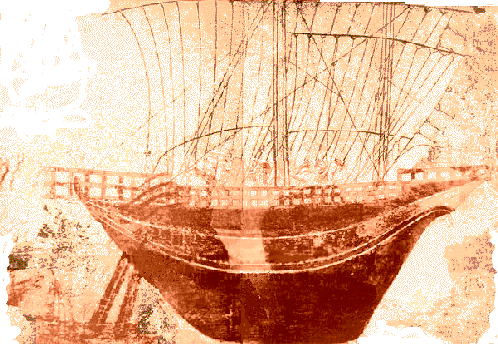
Etruscan ship.
Tomb fresco.
Tarquinia, Italy. |
| |
|
|
Etruscan
Military Defeat and the End of Etruscan Culture
Little by little, the Etruscans lost ground.
The Gauls attacked from across the Alps, sweeping southward.
Control of the sea went to the Greeks of Syracuse at the Battle of Cumae
in the Bay of Naples in 474 BC.
Etruscan power slipped from this point
on--their trade threatened, coastal
ports vulnerable.
One hundred years later, the Etruscans were much weaker, and in 396 BC, the Etruscans lost on land to the Romans.
The Etruscan city of Veii, only
12 miles from Rome and on the other side of the all-important Tiber, had
battled Rome for over a hundred years. Whoever dominated would control
the river and thus central Italy. The end came when the Roman Army
prevailed in a protracted siege
of Veii.
Even in the darkest hour of Veii, the other numerous Etruscan
city-states would not or could not come to their aid. The Romans
triumphed. Abandoning their usual policy of incorporating the defeated,
they enslaved or slaughtered the people of Veii, looted the enormously
wealthy city dry, and gave their property to Roman citizens.
The sophisticated Greeks had prevailed at sea, and
the upstart and unforgiving Romans on land.
The Etruscans failed to keep what they won. After 250
years of success, Etruscan military power faded slowly away like a specter. |
|
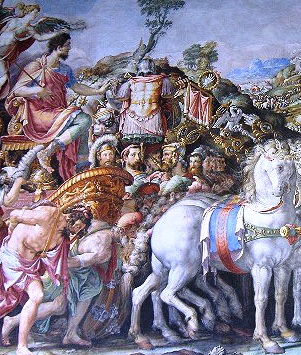
Triumph of Roman
commander Camillus over the (Etruscan) Veii in 396 BC.
Detail. Fresco by Francesco Salviato. 16th c. Florence, Palazzo Vecchio.
Renaissance.
The defeated Etruscans are represented by the
enslaved men in the lower left. Camillus, the Roman general who led the
siege of Veii, is riding in a triumphal
chariot drawn by four white horses. |
|
|
|
| You may
contact me, Nancy Padgett, at
NJPadgett@gmail.com |
|
|
|
|